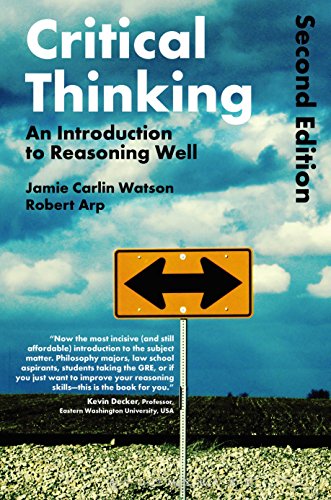

Most ebook files are in PDF format, so you can easily read them using various software such as Foxit Reader or directly on the Google Chrome browser.
Some ebook files are released by publishers in other formats such as .awz, .mobi, .epub, .fb2, etc. You may need to install specific software to read these formats on mobile/PC, such as Calibre.
Please read the tutorial at this link. https://ebooknice.com/page/post?id=faq
We offer FREE conversion to the popular formats you request; however, this may take some time. Therefore, right after payment, please email us, and we will try to provide the service as quickly as possible.
For some exceptional file formats or broken links (if any), please refrain from opening any disputes. Instead, email us first, and we will try to assist within a maximum of 6 hours.
EbookNice Team

Status:
Available4.4
13 reviews
ISBN 10: 147259567X
ISBN 13: 9781472595676
Author: Jamie Carlin Watson, Robert Arp
Part One The basics of good reasoning
1 The basic tools of reasoning
Claims
Different types of claims
Operators
Major operators
Quantifiers
Evidence
Emotions as evidence?
Arguments
Identifying arguments
Real-life examples
2 Evaluating arguments
Extraneous material
Implicit claims (enthymemes and disguised claims)
Questions used as claims
Ambiguity and vagueness
Ambiguity: Lexical and syntactic
Vagueness
Argument form
Two types of argument: Deductive and inductive
Deductive arguments: Validity and soundness
Inductive arguments
Good arguments: The battery analogy
Inductive strength indicators
Strong claims?
Simple and complex arguments
Wrapping up: Evaluating arguments
Real-life examples
Part Two Deductive reasoning
3 Thinking and reasoning with categories
Categories
Relating categories to one another
Standard-form categorical claims
Parts of categorical claims
Translating singular expressions and proper nouns
The traditional square of opposition
The super/subalternation of A-claims and I-claims, and E-claims and O-claims
Conversion, obversion, and contraposition
Translation tips
Syllogisms and testing for validity with Venn diagrams
Valid syllogisms, A-claims and E-claims, and the distributed middle term
The limitations of categorical logic
Real-life examples
2. Mexican Holy Week
4 Basic propositional logic
A new language
Translating English claims into claims of propositional logic
Translating claims with operators
Well-formed formulas
The major operator
Basic translation
Tips for translating more difficult phrases
Translating arguments
Real-life examples
5 Truth tables
Constructing truth tables: The basics
Truth tables for operators
Using truth tables to test for validity: The long method
The long method of testing for validity
Using truth tables to test for validity: The short method
Real-life examples
6 Rules of deductive inference
Deductive inference
Four basic rules of valid inference
Simplification
Conjunction
modus ponens
modus tollens
Eleven valid rules of replacement
DeMorgan’s Laws
Two valid proof strategies
Three mistakes to avoid: Formal fallacies
Real-life examples
Part Three Inductive reasoning
7 Probability and inductive reasoning
Inductive arguments
Inductive strength
Types of probability
Conditional probabilities
Using probability to guide decisions: The cost–benefit analysis
An obstacle: The problem of induction
Real-life examples
General Principle of Reasoning Used
Further Development of Argument
8 Generalization, analogy, and causation
Inductive generalization
Errors in statistics and probability
The regression fallacy
The base rate fallacy
The gambler’s fallacy
Argument from analogy
Strengths and weaknesses of analogies
Causal arguments
Explanations vs. arguments
Evaluating causal arguments
Real-life examples
9 Scientific experiments and inference to the best explanation
Testing causal claims
The structure of a scientific experiment
Simple models of confirmation and disconfirmation
Complex models of confirmation and disconfirmation
Formal experiments
Informal experiments
A problem for causal tests: Underdetermination
A new type of argument: Inference to the best explanation
Explanatory virtues
Applying the virtues
Three examples
Real-life examples
10 Informal fallacies
Formal and informal fallacies
Hasty generalization and false cause
Argumentum ad hominem, abusive (appeal to the man/person)
Argumentum ad hominem, circumstantial
Tu quoque (“you, too” or hypocrite fallacy)
Argumentum ad populum (appeal to the people)
Appeal to snobbery/vanity
Argumentum ad verecundiam (appeal to inappropriate authority)
Argumentum ad baculum (appeal to force)
Argumentum ad misericordiam (appeal to pity or other emotions)
Argumentum ad ignorantiam (appeal to ignorance)
Circular argument (begging the question)
Straw man
Red herring
Slippery slope
False dilemma
Composition and division
Real-life examples
Part Four Application
11 Putting it all together
Applying critical thinking skills
Two readings for evaluation
Hints for evaluation
Hints for evaluation
Additional readings for evaluation
Hints for evaluation
Hints for evaluation
Hints for evaluation
Some assignment suggestions
12 Reasoning on graduate school entrance exams
Introduction to graduate school entrance exams
Basic analytic reasoning questions
Interpreting complicated instructions
Strengthen/weaken questions
Inference questions
Logic puzzles or games
Flaw questions
Parallel-the-reasoning questions
critical thinking vs reasoning
critical thinking an introduction to analytical reading and reasoning pdf
critical thinking an introduction to analytical reading and reasoning
critical thinking an introduction to the basic skills pdf
critical thinking an introduction to reasoning well
Tags: Jamie Carlin Watson, Robert Arp, Critical